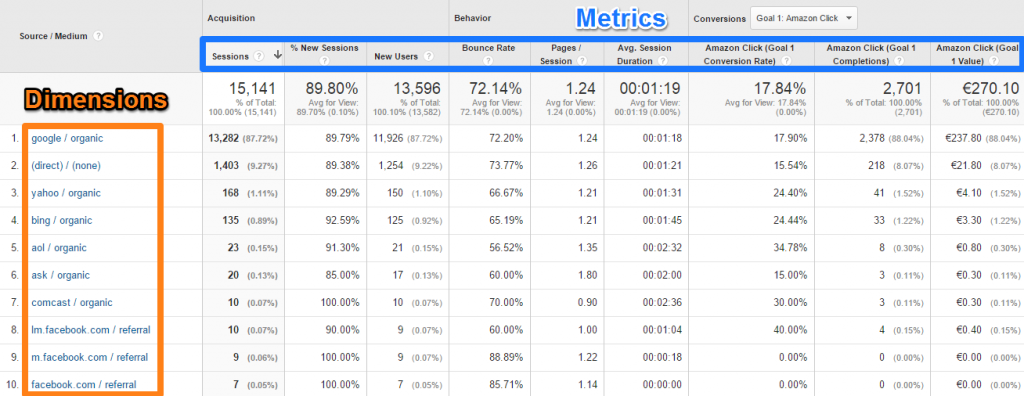Debunking the 'Secondary Dimension' in Google Analytics: Secret Insights
Debunking the 'Secondary Dimension' in Google Analytics: Secret Insights
Blog Article
Decoding the Importance of Secondary Dimension in Google Analytics: Everything About Its Relevance and Impact
In the world of electronic analytics, the application of additional measurements within Google Analytics offers as a critical device for discerning deeper layers of data insights. The value of second measurements exists in their capability to give a nuanced view of customer actions and interaction with a site or platform.
Comprehending Second Measurements in Google Analytics
The understanding of secondary measurements in Google Analytics is crucial for obtaining deeper insights into customer actions and website efficiency. While main dimensions offer fundamental data factors such as web traffic sources and page views, second dimensions permit a more nuanced analysis by supplying additional context to these key metrics. By integrating second measurements, individuals can sector and filter their information to uncover patterns and fads that may not be immediately obvious.

Introducing the Advantages of Second Dimensions
Structure upon the foundational understanding of secondary measurements in Google Analytics, exploring the advantages they use reveals indispensable insights for improving data analysis and decision-making. By including additional measurements, individuals can delve deeper into their data, obtaining a more comprehensive view of customer behavior, material performance, and other key metrics. Among the main advantages is the capacity to segment data, enabling for a much more granular analysis of different dimensions such as traffic sources, tools, demographics, and extra. This segmentation makes it possible for customers to recognize patterns, patterns, and connections that might not be evident when taking a look at data in aggregate.
In addition, secondary dimensions offer context to primary information, using added layers of details that can assist in recognizing user interactions and choices. This boosted understanding can direct strategic decision-making, leading to even more targeted advertising and marketing campaigns, site optimizations, and general enhanced efficiency. Essentially, additional dimensions work as a powerful tool for opening deeper insights and making best use of the energy of Google Analytics for services and web site proprietors.
Leveraging Additional Measurements for Boosted Insights
By using the power of additional dimensions in Google Analytics, services can uncover deeper understandings that drive notified decision-making and calculated optimization initiatives. Leveraging additional measurements permits companies to dive past surface-level information and acquire an extra extensive understanding of user behavior, audience demographics, traffic sources, and site efficiency. For instance, additional resources by integrating primary dimensions like website traffic sources with secondary dimensions such as geographic location or device category, companies can identify which gadgets or regions are driving the most useful website traffic to their site.
Furthermore, additional measurements enable businesses to section and examine information better, assisting them recognize fads, patterns, and possibilities that might have or else gone undetected. By utilizing second dimensions, businesses can tailor their marketing approaches, web content, and customer experience to far better fulfill the demands and choices of their target market. In essence, leveraging additional measurements in Google Analytics equips companies to make data-driven decisions that result in boosted performance, raised ROI, and sustainable growth.

Influence of Second Measurements on Information Analysis
Enhancing information analysis with the usage of secondary measurements in Google Analytics supplies companies with a much deeper understanding of their on-line efficiency metrics. By including secondary measurements, such as time of day, geographic location, or tool group, services can discover beneficial understandings that may have been overlooked with main dimensions alone. This enhanced level of granularity permits even more accurate segmentation of information, allowing organizations to identify patterns, patterns, and relationships that can drive tactical decision-making.

Taking Full Advantage Of Prospective: Second Capacities Strategies
The calculated usage of second measurements in Google Analytics extends past improving data analysis; it includes crafting targeted methods to open the full possibility of useful insights for business development. By employing additional dimensions efficiently, organizations can delve much deeper into their website web traffic, user behavior, and advertising projects to remove actionable understandings. One crucial method is to integrate secondary measurements with key measurements to get a thorough sight of customer interactions. Combining the main measurement of 'source/medium' with second dimensions like 'touchdown web page' or 'gadget group' can reveal which networks are driving website traffic to details pages or how individual actions differs throughout devices.
In addition, utilizing additional dimensions to sector information based upon customer demographics, habits, or technology can aid services tailor their marketing initiatives to particular audience segments. This targeted technique can cause enhanced conversion prices, enhanced customer experiences, and ultimately, raised ROI. By taking full advantage of the capacity of additional measurements in Google Analytics, services can make educated decisions, optimize their online visibility, and drive sustainable growth.
Conclusion
In conclusion, secondary dimensions in Google Analytics play a vital role in providing much deeper understandings and enhancing data evaluation. Integrating secondary measurements right into information evaluation strategies can lead to more enlightened decision-making and improved total performance.
While main measurements provide basic information factors such as website traffic sources and page views, additional measurements allow for a much more nuanced evaluation by offering extra context to these key metrics. By integrating main dimensions like traffic resources with additional dimensions such as geographical area or gadget classification, services here can recognize which tools or regions are driving the most useful web traffic to their internet site.
By including second dimensions, such as time of day, geographic location, or device category, companies can reveal beneficial insights that may have been overlooked with primary dimensions alone. One essential approach is to combine second dimensions with primary dimensions to acquire an extensive sight of user communications. Matching the primary dimension of 'source/medium' with second measurements like 'landing web page' or 'gadget classification' can disclose which networks are driving website traffic to certain web pages or just how individual actions varies throughout gadgets.
Report this page